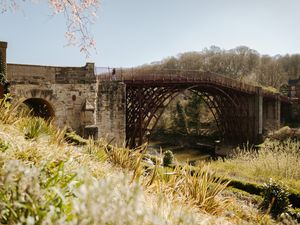Beavers to be released in Shropshire Hills enclosure as part of river project
A breeding pair of beavers are to be released into a Shropshire Hills enclosure next week.
Watch more of our videos on ShotsTV.com
and on Freeview 262 or Freely 565
The Severn Rivers Trust, in collaboration with landowner Trevor Wheeler, the Environment Agency, Shropshire Wildlife Trust, and the Shropshire Hills National Landscape Team, will release the beavers into the new enclosure on Monday (March 31).
The team behind the release say the aim is to help restore natural processes in the "precious upland landscape".
Severn Rivers Trust, with input from key partners and the Derek Gow Consultancy, is leading the project.
It said the breeding pair of beavers will be released into a 6.5-hectare enclosure in the headwaters of the River Clun, where their activity will help "hold more water in the landscape, slow the flow, create vital wetland habitats, and improve conditions for the river and communities downstream".
Beavers are known as 'nature’s engineers', and are capable of transforming landscapes in ways that support a huge variety of species.
As they build dams and create wetlands, they naturally store water in the landscape, reduce the impact of flooding, and keep rivers flowing in dry spells.
A statement ahead of the release said: "This makes them a particularly valuable species in the uplands, where rivers like the Clun often experience flash flooding in winter and dangerously low flows in summer. Their work will not only help regulate water availability but will also provide significant benefits for biodiversity, creating habitats for a range of wildlife."
Joe Pimblett, CEO at Severn Rivers Trust, said: “If we’re serious about restoring nature in Britain, we need to start tackling issues at the source.
"The exceptional challenges facing our rivers, including declining water quality, increased flooding, and habitat loss, require fresh and bold approaches. By bringing beavers back to the uplands, we are working with nature to rebuild healthier and more resilient landscapes from the headwaters down.”
Luke Neal, head of landscape recovery at Shropshire Wildlife Trust, said: “Working with private landowners is pivotal in our mission to see 30 per cent of land managed for nature by 2030, and we are thrilled to see our long-standing relationship with Trevor result in the introduction beavers to address wetland management, create habitats and improve river quality in the River Clun catchment."
Having recently released two beavers into an enclosure in Shrewsbury as part of the Shropshire Beaver Project in partnership with Shrewsbury Town Council, Shropshire Wildlife Trust will be using the lessons and expertise to ensure the safe and successful release of beavers elsewhere in the county.
The River Clun and its tributaries are described as a critical and fragile ecosystem, home to species that need clean, well-oxygenated water to survive, such as Atlantic Salmon.
The team behind the project said: "By slowing water flow and trapping sediment, beaver wetlands will help improve water quality, benefitting not only fish populations but a whole range of plants and animals that depend on healthy rivers.
"The site has been carefully chosen for its potential to support both beavers and wider biodiversity.
"As well as creating new wetland habitat, short-term cattle grazing will be introduced at key times to maintain the species-rich grasslands surrounding the site. To help the beavers establish their new home in the Shropshire Hills, a temporary lodge has been built on a pond within the enclosure, giving them an ideal starting point to settle and thrive.
"This project has been made possible with funding from the Environment Agency and additional support from the Shropshire Hills National Landscape Team.
"The beavers set to be released were relocated under licence from Scotland by experts at the Beaver Trust and are a breeding pair, both estimated to be two to three years old.
"They have passed full health screening and will be introduced to each other naturally within the enclosure, allowing them to establish their own space before meeting."
Mr Pimblett added: “We’re looking forward to seeing the beavers settle into their new home and watching the landscape change over time. What they do here in the headwaters will have an impact far beyond the enclosure.”





